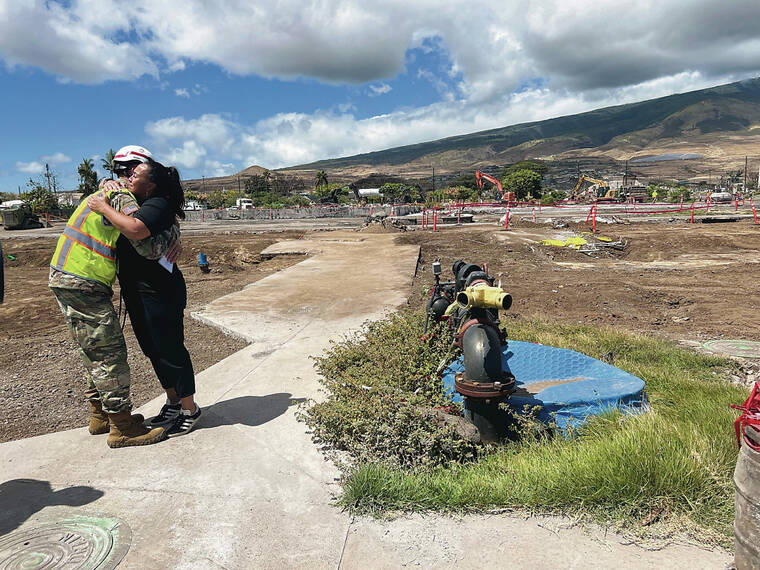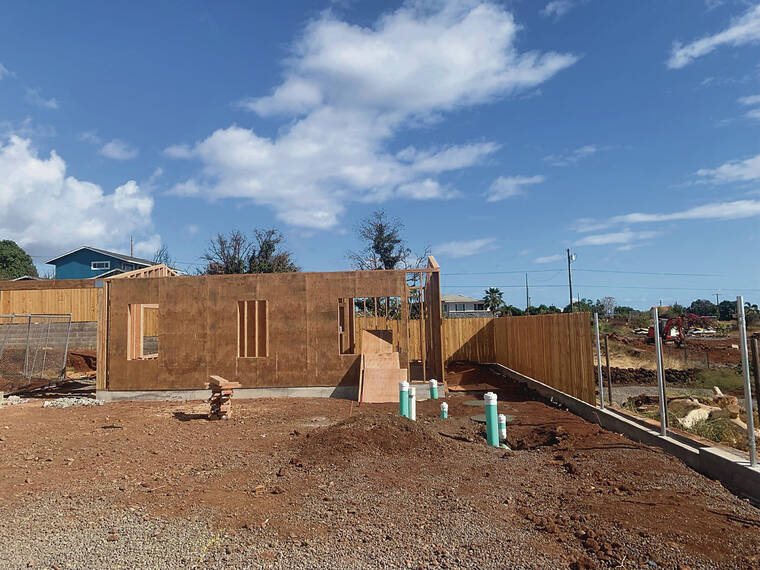Rebuilding begins in Lahaina wildfire impact zone
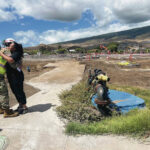
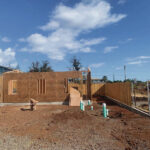
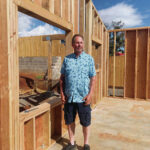
LAHAINA — Walls are going up on Lahaina resident Gene Milne’s Malanai Street property — the first under construction in the Lahaina wildfire impact zone, where the historic town was destroyed Aug. 8 in the deadliest U.S. wildfire in over a century.
The walls represent healing for Milne, whose home was under construction when the flames whipped through his neighborhood. They are a sign of how far the Lahaina community has come as it prepares for the fire’s first anniversary.
ADVERTISING
They also represent an opportunity to bring hope to those grappling with the harsh realities of a fire that killed least 102 people, burned nearly 3,000 acres and destroyed or left uninhabitable some 3,900 structures, most of them homes and many that housed multiple families.
“I always thought it was going slow, but it isn’t. It feels slow because you are stuck, you are just in limbo. I’m moving forward now,” Milne told a group of Hawaii reporters who visited his home and three other stops in the impact zone Wednesday.
The county organized the invitation- only, escorted tour to showcase recovery work. Maui Mayor Richard Bissen, who was part of the tour, said, “We are here today to show you the great progress that’s been done in our recovery here in Lahaina.”
Jennifer Gray Thompson, CEO of After the Fire USA, which was created by wildfire survivors and experts to support fire-ravaged communities, called the start of construction in the Lahaina wildfire impact zone an important community milestone.
“What’s really important in a megafire like this one, and every single one, is visual deliverable of progress and hope, and that’s what you are providing here for your community,” said Gray Thompson, who went through the massive wildfire in October 2017 that devastated the California North Bay Counties of Sonoma, Napa, Lake and Mendocino.
On nearby Komo Mai Street, Kim Ball’s effort to begin rebuilding the 5-year-old home that he lost in the fire also is an encouraging sign.
“A couple of days after the fire, I reached out to our contractor,” he said. “I’m in my 70s, and I want to get it done in my lifetime. As soon as the permit office opened, he was ready to go with our plans from before.”
•••
The lush leaves of the Lahaina Banyan Tree made it past its 151st birthday two months ago despite fire- ravaged limbs; it continues to sprout more green shoots.
There also were rows and rows of gravel-covered lots, an indication that debris and toxic ash have been removed. Col. Eric Swenson — U.S. Army Corps of Engineers recovery field office commander — said residential debris removal is expected to end in January, with commercial debris removal slated for completion in February.
“We’re ahead of schedule on both,” Swenson said, adding that debris has been removed from 92% — or 1,283 out of 1,399 — of residential lots and from 31% of commercial properties, or 50 out of 159.
Swenson said cleared properties are turned back to the county, when owners can apply for new building permits.
John Smith, Maui County Department of Public Works Highways Division chief/recovery infrastructure lead, said infrastructure projects are ongoing, with more coming.
“Our goal early on was we need to get this town functional so that people can repopulate,” Smith said. “We’ve accomplished that primarily so far, and by the end of this year, we should have service restored 100% for water and sewer. That doesn’t mean it’s all going to be perfect. We’re going to limp along for a while.”
Kimo Langraf, Maui County deputy director of water supply, said the county has returned to drinking water standards in burn sectors 1, 2, 3a, 3b, 4a, 4b, 4c, 4d, 4e and 6b.
“The remaining area is in 5 and 6, which is the really heavily damaged burned areas,” he said. “Everything is on track right now, and we expect to have all the water in Lahaina (returned to drinking water standards) by August.”
Construction noise was constant as cleanup and rebuilding occurred simultaneously.
“You don’t usually see rebuilding happening at the same time,” Gray Thompson said. “It’s a trauma response to be like, ‘Why isn’t this faster?’ In a year people will say to you, ‘Why isn’t it rebuilt?’ That’s just an unrealistic expectation. You are moving really quickly here in Maui. You are doing the right thing. You are doing it on the most remote place on the planet, too, with a legacy of colonialism with the holiest place in all of Hawaii in the burn scar.”
The time to rebuild is different for everyone, and there is some community concern that owners in complicated situations might give up. A new report recently released by the Hawai‘i Land Trust indicates that without intervention Lahaina could see an estimated 6.5% of residential properties totaling $122 million change hands over a year, and within three years a 20% turnover of ownership equating to at least $360 million.
Bissen acknowledged that Milne’s effort is an outlier because of the open permit, but said Ball’s home is an example of a standard permit application that is “moving forward.”
“What’s really going to determine people’s ability to move back is their financial situation,” he said. “It’s not the permitting, but the ability to fund and pay for the home.”
Bissen said the county has focused on debris cleanup but is now talking to financial experts and nonprofits about how government might leverage funds and form partnerships to alleviate barriers to rebuilding such as those created by insurance claims and mortgage situations.
“Everything is on the table,” he said.
•••
Bissen said he recently went to Washington, D.C., to petition Congress to release Community Development Block Grant Disaster Recovery — or CDBG-DR — program funds, which could provide Maui with significant funding for permanent housing.
“The big push needs to be before the end of this federal fiscal, which is October,” he said.
Kekai Keahi, a longtime West Maui carpenter and homebuilder, said community perceptions of the Maui recovery effort are mixed. Generally, he said people view cleanup efforts favorably.
“We thought it would take two or three years, and it’s not even a year out and it’s almost done, so when it comes to the cleanup, that’s an ‘A’ (grade),” Keahi said.
He also praised the county and county contractor 4Leaf on the building permit process for properties that have a clear path to rebuild. However, he said there are about 1,000 homeowners in Lahaina’s historical districts and shoreline management area, where rebuilding plans could trigger HRS Chapter 343 relating to environmental impact statements.
Keahi said HRS 343 is particularly challenging for those who lived in one of Lahaina’s multigenerational homes, as those who seek to rebuild a single-family home with more than 3,500 square feet or multiple units together totaling more than 3,500 square feet are not exempt.
He said HRS 343 also makes it difficult for some owners to rebuild accessory dwelling units, which may be needed to house family members or to generate income to qualify for a new mortgage, especially in cases where the owners were underinsured.
“I agree with about 85% of that statute,” Keahi said. “It’s just that now in this situation this statute is hurting our community, so places where they got the permits are starting to rebuild. The other half of Lahaina, which is in the historical district, cannot.”
He said he has discussed the situation with county officials and that he and others brought it up Saturday during a county Historical &Business Districts Neighborhood Planning Workshop, which drew hundreds of residents to the Lahainaluna cafeteria.
“We got to discuss what the challenges are and what’s going on and how we can work together to move ahead,” Keahi said.
He said Gov. Josh Green could move the issue forward by adding language that addresses the challenges of HRS 343 to his next emergency proclamation.
“When we started out, the actual communication between the community and the county and state government in terms of what we see for our future was an ‘F,’ but has now come around to about a ‘C’ level,” Keahi said. “If they listen on HRS 343, I can easily change their grade to a ‘B+.’”

